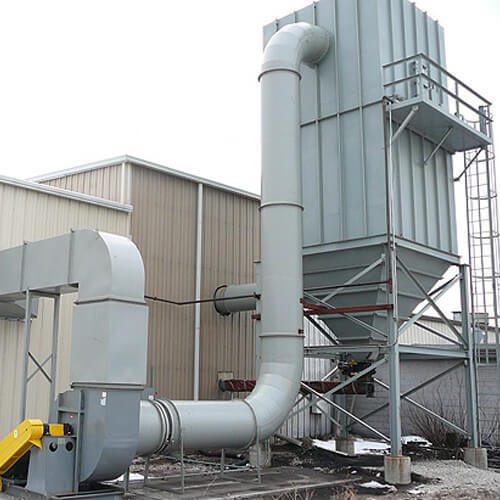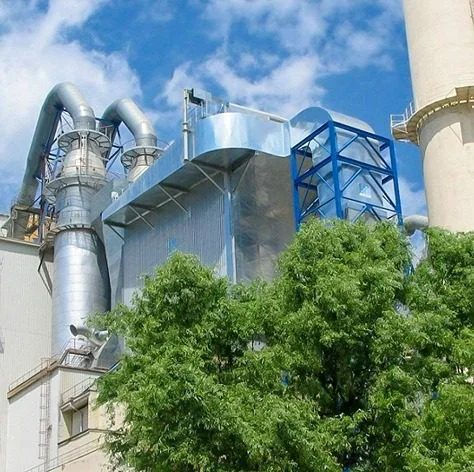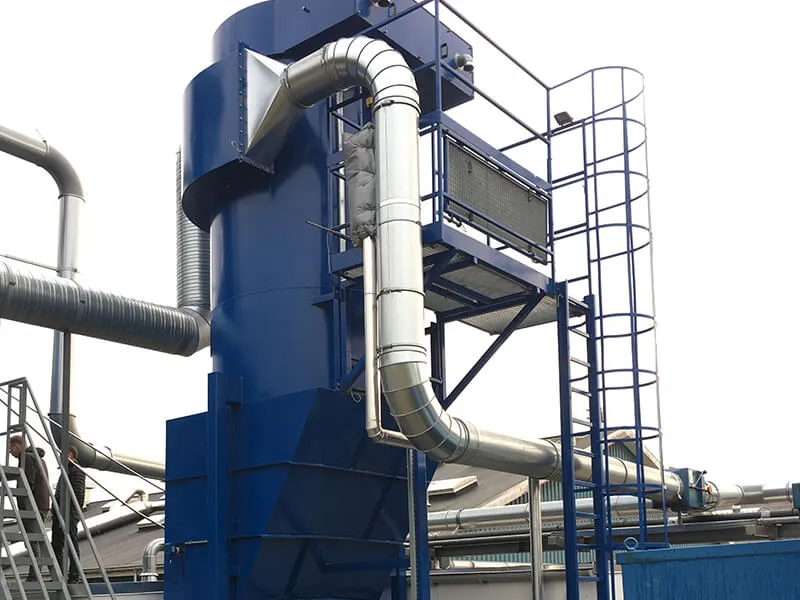In the realm of industrial dust separation, ensuring a clean and efficient operational environment is crucial for maintaining both regulatory compliance and optimal production performance. Companies spanning various industries—from cement production and metal manufacturing to power generation and waste management—must consistently address the challenge of capturing and removing dust particles generated during their processes. Without effective dust separation systems in place, these particles can not only compromise air quality but also lead to equipment wear, reduced efficiency, and even potential health hazards for employees.
To tackle this issue, two widely embraced technologies are cyclones and multiclones, both of which are types of centrifugal separators. These systems harness the power of centrifugal force to effectively separate dust particles from gas streams. Although cyclones and multiclones share a fundamental operating principle, the differences in their design, efficiency levels, and suitability for various industrial applications make them distinct solutions. Cyclones are typically favored for simpler, large-particle separation needs, whereas multiclones excel in applications requiring the capture of finer dust particles.
This article aims to provide a detailed comparison of these two dust separation technologies, focusing on their respective operating mechanisms, their efficiency in capturing particles of different sizes, and the various factors that can influence their overall performance, such as particle size distribution, inlet velocities, and energy consumption. By examining these key aspects, businesses can make informed decisions about which solution best fits their specific operational needs.
Additionally, we will highlight how Intensiv-Filter Himenviro plays a pivotal role in optimizing dust separation processes for a wide range of industries. With decades of experience and a deep understanding of dust control challenges, Intensiv-Filter Himenviro offers tailored solutions designed to maximize separation efficiency, minimize energy consumption, and ensure compliance with environmental regulations. Our expertise in customizing both cyclone and multiclone systems ensures that each solution is uniquely suited to the demands of the application, helping companies achieve superior dust control, operational efficiency, and cost-effectiveness.

Cyclones: Simple Yet Powerful Dust Separators
Operating Principle
Cyclones function through a relatively straightforward, single-stage mechanism. When a gas stream enters the cyclone tangentially, it is forced into a spiral motion. This rotational movement generates centrifugal forces that expel dust particles toward the outer walls of the cyclone. As these particles collide with the walls, they lose momentum and fall into a collection chamber, while the cleaned gas is discharged from the top. This efficient design allows cyclones to effectively manage a significant volume of dust-laden air with minimal maintenance requirements.
Efficiency
Despite their effective design, cyclones are primarily adept at separating larger particles, typically those greater than 10 microns in size. Their efficacy diminishes significantly with finer particles, particularly those measuring less than 5 microns. By leveraging the centrifugal forces generated by their design, cyclones are ideal for operations where the dust particles are larger and less demanding of stringent filtration.
Factors Affecting Performance
The performance of cyclones hinges on several key factors:
- Particle Size: Larger particles experience stronger centrifugal forces, making them easier to separate from the gas stream, while smaller particles tend to require more sophisticated methods for effective capture.
- Inlet Velocity: The velocity at which gas enters the cyclone can influence separation efficiency. Higher inlet velocities generally improve the separation process, but they also contribute to increased pressure drop and energy consumption.
- Design Characteristics: Dimensions such as the diameter and height of the cyclone directly impact its performance. Smaller diameters may enhance particle capture efficiency but can elevate energy costs if not properly managed.
Discover Our Range of Solutions:
Multiclones: Enhanced Efficiency for Fine Dust Separation
Operating Principle
Multiclones represent an evolution of cyclone technology. Instead of a single cyclone, multicyclones consist of multiple smaller cyclones arranged in parallel. This configuration permits improved dust separation, particularly for finer particles that standard cyclones struggle to capture. Each mini-cyclone in the multiclone system operates under the same principle as traditional cyclones, but the overall design heightens the centrifugal force acting on particles due to the smaller diameter of each cyclone.
Efficiency
Multiclones excel in the realm of fine dust separation, capturing particles as small as 5 microns with commendable efficiency. Their capacity to separate a broader spectrum of particle sizes significantly enhances their utility in industries that require more rigorous dust control measures. This makes them ideal solutions for sectors such as pharmaceuticals, food processing, and other applications where air purity is non-negotiable.
Factors Affecting Performance
The efficiency of multiclones can be influenced by several factors unique to their design and operation:
- Cyclone Quantity: The number of mini-cyclones in a multiclone setup can impact overall efficiency; a higher number of cyclones typically leads to improved separation efficacy.
- Gas Flow Distribution: Maintaining a uniform distribution of gas flow across the mini-cyclones is crucial for optimal performance. An uneven flow may lead to suboptimal dust collection and reduced system efficiency.
- Pressure Drop: The presence of multiple small cyclones can result in higher resistance to gas flow, leading to increased pressure drops across the system. Managing energy consumption in tandem with maintaining performance levels is vital in multiclone operations.
Efficiency Considerations for Dust Separation
When determining the most appropriate dust separation solution, the efficiency of cyclones versus multiclones becomes evident through several consideration points:
- Particle Size Distribution: Multiclones typically outperform traditional cyclones when the challenge involves smaller particles, making them the go-to option for operations demanding high levels of filtration efficiency.
- Operating Conditions: Cyclones often find favor in simpler applications involving larger particles, while multiclones are more suited for environments where fine filtration is a priority.
- Energy Consumption: While multiclones prove to be more efficient for fine dust capture, they often necessitate a greater energy expenditure due to the additional components and potential pressure drops. Therefore, a balanced approach to energy management is essential to keep operational costs in check.



Customization with Intensiv-Filter Himenviro
At Intensiv-Filter Himenviro, we specialize in designing and optimizing both cyclone and multiclone dust separation systems tailored to meet the specific needs of diverse industrial applications. Our experienced team evaluates each client’s unique dust separation requirements, ensuring that we deliver the most effective and economical solutions available. Below are some of the ways we assist clients in achieving optimal dust separation:
Custom Design
Understanding that each industrial operation is distinct, we tailor our cyclone and multiclone systems to align with individual operational requirements. Whether the focus is on particle size, gas flow dynamics, or pressure drop considerations, our designs prioritize enhanced performance without compromising energy efficiency.
High-Efficiency Solutions
Our multiclone systems are purpose-built to maximize separation efficiency for fine particles, thereby minimizing emissions and enhancing air quality in industrial environments. In industries where compliance with stringent air quality regulations is critical, our solutions deliver reliable performance.
Energy Optimization
A core principle of our design philosophy is to ensure that systems maintain high dust separation efficiency while managing energy consumption. By striking a balance between performance and cost savings, we help clients achieve sustainable operations without compromising on efficiency.
End-to-End Support
Our commitment to client success extends beyond system design and installation. We offer comprehensive support throughout the lifecycle of the dust separation system, including regular maintenance, performance assessments, and troubleshooting, ensuring your operations continue running at peak efficiency.
Industry Experience
Having accrued extensive experience across various sectors including cement production, metal processing, power generation, and food manufacturing, we possess a nuanced understanding of the unique dust separation challenges faced by each industry. This breadth of knowledge allows us to provide tailored recommendations that are responsive to specific operational concerns.
Conclusion
In conclusion, both cyclones and multiclones are highly valuable technologies for industrial dust separation, each offering unique advantages depending on the specific operational requirements. Cyclones are particularly well-suited for applications where larger particles need to be separated, making them a cost-effective and efficient solution for industries with less stringent dust control needs. Their simple design, ease of maintenance, and lower operating costs make cyclones ideal for processes where capturing coarser particles is the primary objective.
On the other hand, multiclones are engineered to provide superior dust separation efficiency, particularly when it comes to fine particles. Their ability to handle a wider range of particle sizes, especially smaller and more challenging dust particles, makes them a more advanced solution for industries that require stringent dust control and cleaner emissions. Despite their slightly higher energy consumption and complexity, multiclones are often the preferred choice in industries that demand higher filtration precision, such as power generation, cement production, and metal processing.
By thoroughly understanding the technical differences, design characteristics, and performance considerations of both systems, businesses can make more informed decisions when selecting the most appropriate dust separation solution. Key factors such as particle size distribution, operational conditions, and energy efficiency should be carefully evaluated to ensure the dust control process is optimized for both performance and cost-efficiency.
At Intensiv-Filter Himenviro, we bring decades of expertise in designing and implementing dust separation solutions tailored to the specific needs of each industry. Our team is dedicated to providing personalized solutions that enhance dust separation performance, reduce energy consumption, and comply with environmental regulations. Whether you require a cyclone system for large particle separation or a multiclone setup for fine dust filtration, our experts can design and deliver a solution that aligns with your operational goals.
We encourage you to reach out to us to explore how Intensiv-Filter Himenviro can help your organization achieve the highest levels of dust control. By partnering with us, you can ensure a cleaner, safer, and more efficient working environment, ultimately enhancing the overall productivity and sustainability of your operations. Let us assist you in selecting the most suitable dust separation solution that meets your unique requirements and contributes to the long-term success of your business.













